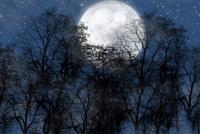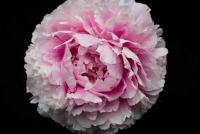The combination of shrubs in landscape design. Amazing combination of shrubs with decorative foliage
The presence of free space on the site may give the owner the idea of creating additional decorations. Ornamental shrubs will cope well with this role - their use in landscape design will allow to embody the most daring and interesting ideas.
Where it is better to plant trees and shrubs, and what plants to choose to create original compositions, will tell today "Dream House".
Shrubs on the site: the principles of choosing a landing site
When choosing a place, you should remember three important points:
- firstly, perennial shrubs and they will live in the allocated space for more than ten years, so it is necessary to immediately assess how much the land occupied by plantations can be affected by further re-planning;
- secondly, many "green" in the ultimatum form impose their requirements on natural conditions. They should be taken into account so that the heart does not bleed at the sight of a juniper burning in the sun or a forsythia dying in the deep shadow. In addition, many varieties of ornamental shrubs do not tolerate dry and cold winds;
- thirdly, a small bush, planted next to the path, can in a few years become a serious obstacle to moving around the site, that is, you need to take into account the dimensions of an already adult plant.
Orientation - North
Before planting plants that can exceed 1.5m in height, one intangible but important aspect must be taken into account, namely the shadow that they cast:
- Experts advise to plant decorative low-growing shrubs on the south side of the garden, the tall ones on the north.
- To avoid problems with neighbors who may also need sunlight, trees should be planted at a distance of three meters from the fence, and bushes - one and a half meters.
- Near and on the north side of the house you can plant low shade-tolerant shrubs for the garden.
- The photophilous, which are flowering and fruiting plants, should be placed so that they receive the afternoon rays.
- To facilitate the planning of landing, it is advisable to make an approximate "shadow" map of the site. The seedlings define the "south" side, on which the branches are longer and thicker. If you combine the south of the acquired young and the south of the plot, the bush will take root faster.
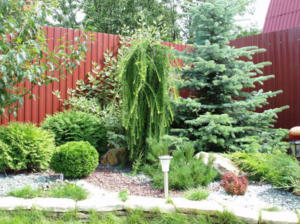

Coniferous ornamental shrubs
How to make a composition of ornamental shrubs
Beauty and benefits
A shrub may have a practical function, being a green hedge, border or natural protection of other plants from the sun and wind.
It is able not only to close a not very picturesque fence, but also to ensure the inaccessibility of the garden - what are the thorns of hawthorn and barberry! Such hedges can be cut or left to their natural shape. It is important to decide for the first year or two of the life of the chosen ward, since more mature plants may be poorly clipped.
Border is used more often for edging paths, planting low bushes. As a decoration of the garden often use a single landing, the so-called tapeworm. "Solo" can hydrangea, spirea, rhododendron. Some plants outside the flowering period in a single planting may look awkward, so they are used in a composition of three or more plants.
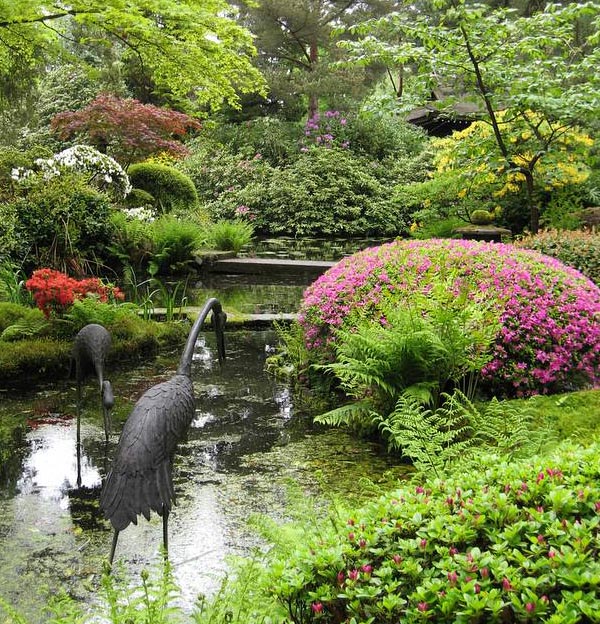
Decorative trees and shrubs photos
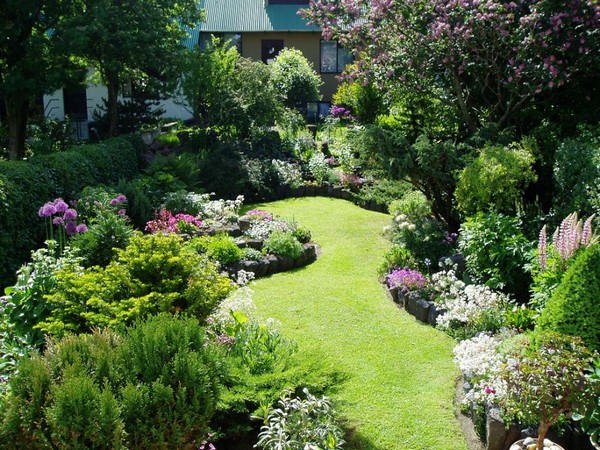
What shrubs to plant in the country
Good neighbors
To avoid unhealthy competition within the group, you should choose shrubs that fit well with each other. The science of composing a composition of ornamental shrubs is quite complicated, so it is best to turn to the established practice.
Specialists, for example, offer the following combinations:
- red barberries - fortizia middle or rhododendron;
- lilac - Japanese quince or Chubushnik or Maak's honeysuckle or rhododendron;
- spirea - hydrangea or mahonia.
Beautiful flowering shrubs for the garden (south) are advantageously combined with coniferous plants, such as thuja western and ornamental forms of juniper (north).

Ornamental shrubs to give photos

Green dozen
The range of shrubs is undoubtedly large, but in Russian conditions it is limited to winter hardiness. So, a dozen of the most popular barberry opens Thunberg. Hawthorn photophilous, prickly and smelly when flowering, but with edible fruits. Quince fruits are also edible, but the wolfberry is beautiful, but poisonous. Juniper has 70 varieties, varying in shape. Rhododendron bloom beauty can compete with. Hungarian lilac - unpretentious, blooms a month later ordinary. Spirea - amazingly beautiful deciduous shrub with white, pink, red or crimson flowers. Forsythia blooms when all other plants are just starting to turn green, including herself. Chubushnik incorrectly called jasmine, its winter hardiness depends on the variety. Camellia blooms with large flowers from autumn to mid-spring, some varieties withstand temperatures up to minus 20 ° C.
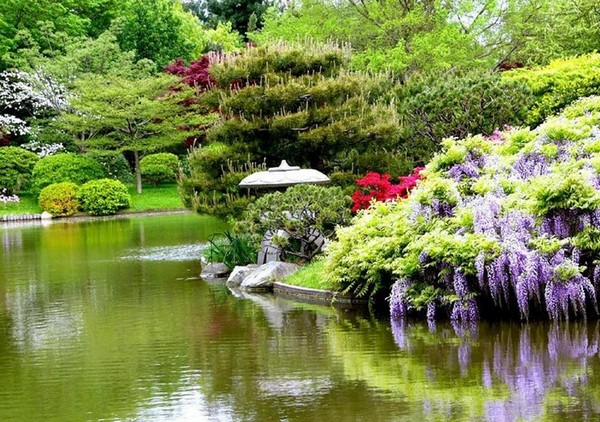

Decorative shrubs in landscape design
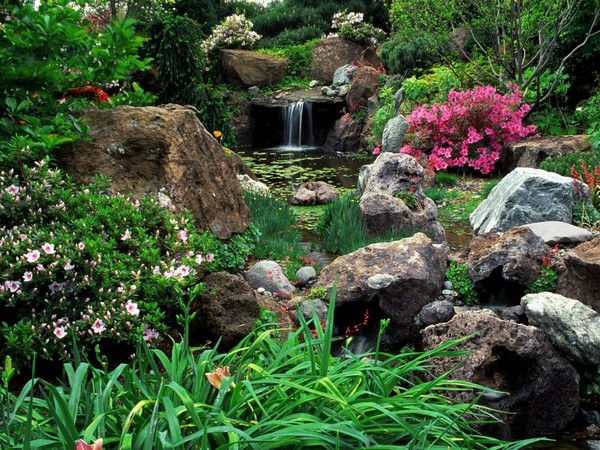
The use of ornamental shrubs in landscape design is especially popular in Japanese gardens. Also, they touched and art - the creation of green sculptures.
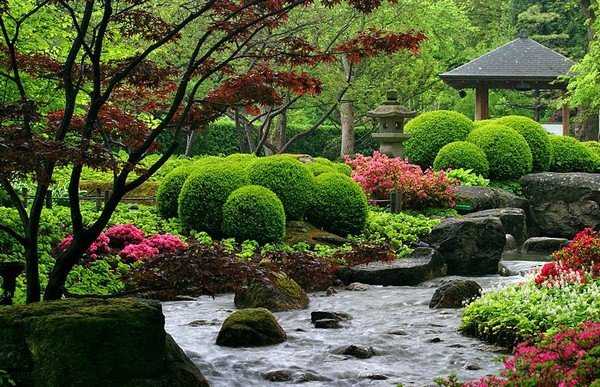
Decorative shrubs for garden photo


Ornamental shrubs for the garden
If you wish, you can recreate any picture, considering the composition of the bushes in different gardens, parks, cottages. But it is always more interesting to create something of your own, original and unique. Create and decorate your site yourself!
Beautiful landscape compositions look very stylish. This direction of design must be given a sufficient amount of not only time and effort, but also attention. In this case, it is of great importance not only which plants are used to design one or another area, but also how they are in harmony with each other and whether they correspond to the general chosen style of decoration.
Main details
Ways of planting a particular park, garden or small garden plot are quite an important issue faced by the gardener. But no less important is the question concerning the creation of compositions from shrubs, trees, flowers and other elements. In order to successfully cope with the task of beautiful and high-quality design of the garden, you need to know the basic techniques that are used by both professional designers and experienced amateur gardeners.
The main principles of design
Creating mixborders and flower gardens, it is important to consider the basic principles according to which the original decor of the garden plot is carried out. The most important of these are the following:
- all season planting;
- unity floristics;
- layering landings.
In order not only to understand, but also to implement each of these principles, it is important to pay special attention to which plants you choose for a flower bed or a large flower garden. So, implementing the principle of tiered, familiarize yourself with the physical characteristics of the acquired flowers, bushes or trees. It is necessary to plant them in such a way that no plant is closed by another. That is why low squat plants are planted in the foreground of the flowerbed, which will become a kind of border and will not exceed 20-25 cm in height. The next row may consist of those representatives of the flora that grow up to 40-45 cm in height. Further planting schemes are observed in accordance with the dimensions given. Thus, the third row consists of plants with a height of 60-65 cm and so on until the use of conifers or deciduous shrubs and trees. They land on the farthest plan of the flower bed, as they will be clearly visible there.
The need to implement the principle of tiered is primarily due to the fact that they allow you to view the flower garden in all its beauty. Well, you should not lose sight of the fact that the tiered arrangement of flowers ensures maximum and uniform illumination of plants of each type, and this, in turn, allows plants to grow and develop healthy and beautiful.

Using ready-made landscape compositions is quite easy and, most importantly, advantageous in almost any respect, because in this case you have the opportunity, without resorting to additional efforts and costs, to get on your site an excellent composition that has been tested and tested on several previous garden plots professional gardeners and designers. However, in these cases problems also occur. For example, they may be related to the fact that the area is insufficiently lit and the selected plants will not be able to properly grow in new conditions. In addition to the above factor, attention is drawn to the composition of the soil on the site. Very much depends on him too.
In order to avoid such failures, it is necessary to heed the advice of professional landscape designers. So, in order for a flower garden to be decorative (it retains a blooming and beautiful appearance) during its entire growing season, which usually lasts from early spring to late autumn, it is necessary to clearly know which plants start and end flowering during what period. It is on this principle that the selection of plants in the flower bed should be carried out.
Most of the flower beds reaches maximum decorativeness in the middle - second half of the summer. Usually, daylilies bloom in such flower beds, which allow you to see yourself and delight everyone around for a whole month. In addition to these plants, in the blooming flowerbed of midsummer you can find Verginsky Veronikastrum (or Veronica), traditional and irreplaceable roses, bright spreading astilbeas and stevia - the brightest plant that reaches a height of 2 m.
But you should not dwell only on the varieties of flowers presented earlier, because they miss the spring and autumn, during which we also want to please the gaze with beautiful and spectacular buds. So, for the May part of the flower garden rhododendron will be an excellent solution. It blooms in May and does not allow even those who faced this majestic image to tear off their eyes from themselves. Immediately after the rhododendron has faded, and this usually happens in early June, a stunning flower called spiraea blooms. It can be presented in completely different colors, but most often it is delicate white or pink shades, which are embodied in small elegant inflorescences, so it is perfectly included in the general ensemble of a flower garden.
For the so-called tamping of a flower bed and to create, as has already been said, a peculiar border will look very majestic but very impressive. These are bright all-season flowering plants, which can also be embodied in different colors, but most often they are, of course, red, bright red or lemon yellow shades. They will look amazing in the foreground of any flower bed, so you should pay special attention to them when choosing plants and to decorate exactly the 1st, lower tier.
Well, at the end of the period can be noted such a plant as an euonymus. All the time it usually grows shrub with greenish leaves, but then it begins to change its color, which in September becomes somewhat bluish, gradually turning into red. As a result, the shrub becomes a beautiful and spectacular hat of the entire flower garden. Do not forget about the conifers - small shrubs and large trees, which allow you to diversify the unity of flowers. Since they always remain in the state in which we see them both in winter, and in summer, and in autumn, and in spring, this bright green or slightly brownish color of conifers will dilute the overall plot and color scheme. Do not have to worry about the fact that a particular site will look unattractive in the autumn or winter periods.
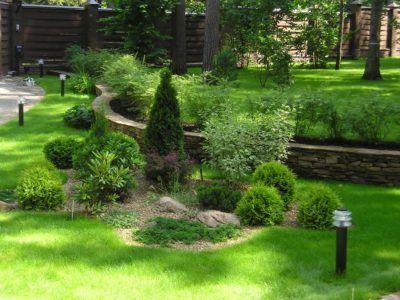
Coloring compositions
The next item, which you also have to pay attention to, is related to the color scheme used in a particular area of your garden.
Much in this case depends on the style in which most of the territory of your garden is decorated.
And be sure to pay attention to the style in which these or other buildings on the site were built. Depending on this, the selection and selection of certain shades and inflorescences will occur. So, for example, if your garden was created in order to relax in it - read a book, meet friends or just lie down, sunbathe in the sun, then most often for such a solution you should choose calm, classic colors that are perfectly combined with each other.
In this case, it will be necessary to choose, for example, pink shades from pale and slightly noticeable to bright enough. Also, do not neglect the red, yellow and bluish shades. Here the main move in the color work is due to the fact that against the background of soft and warm hues contrasting inclusions are used. So, in the foreground, in addition to marigolds, which are most often used to create a bright image, you can use landscape compositions that will emphasize more greenery, but at the same time have a distinctive color. For example, it may be a plant like geykher. This plant differs from the others in that its foliage is colored not in green, but in purple. For this composition great solution will use echinacea, which blooms in the same color scheme. It is a color range from light purple to a rather deep lilac color. In the background, after echinacea, Veronikastrum can be planted, which is a very tall and beautiful plant of various shades - from snow white to blue. The shades of pine needles are perfect for him, so do not forget about blue spruce.
And a little about the secrets ...
Have you ever experienced unbearable joint pain? And you know firsthand what it is:
- the inability to move easily and comfortably;
- discomfort when climbing and descending stairs;
- unpleasant crunch, clicking not at own will;
- pain during or after exercise;
- inflammation of the joints and swelling;
- unreasonable and sometimes unbearable aching pain in the joints ...
And now answer the question: does it suit you? Is it possible to endure such pain? And how much money have you already “leaked” to ineffective treatment? That's right - it's time to stop this! Do you agree? That is why we decided to publish an exclusive interview with Professor Dikul, in which he revealed the secrets of getting rid of joint pain, arthritis and arthrosis.
Decorative - deciduous shrubs - is a "magic wand" in the garden. These plants do not lose their beauty all season due to the color or texture of foliage. For such plantings easier to care for. Fortunately, nowadays there is such an abundance of species and varieties that you just need to get acquainted with them - and the garden will play with new bright colors.
There are several approaches to the combination of decorative - deciduous shrubs.
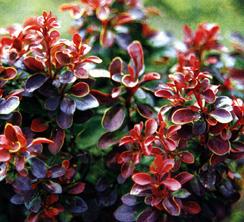 Plain
Plain
Hedges, backstage or loose groups of shrubs from one variety of decorative - leafy plant. Such groups look bright and simple.
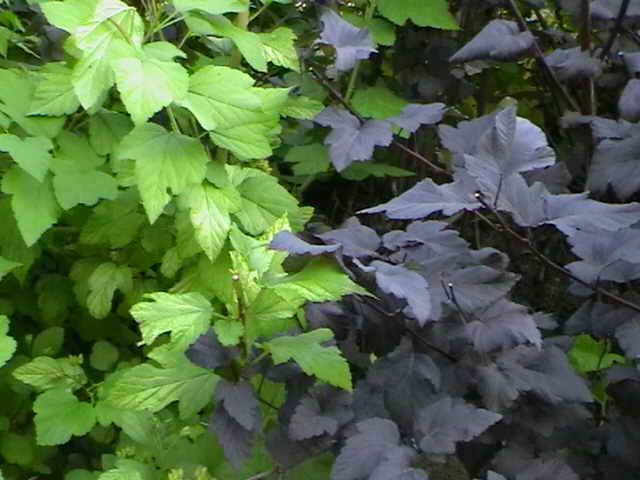 Rhythmic
Rhythmic
In this case, the plant of the same or different species is repeated with equal pitch or in a checkerboard pattern, creating a certain “rhythm”. For example, Diabolo and Luteus blisters are alternating due to different foliage coloring: burgundy and golden. For rhythmic repetition, white and pink-yellow varieties of white deer are also suitable: Elegantissima and Cream beauty are a combination of varieties of barberry Thunberg: Admiration and Golden Ring or Red Pillar and Green Carpet. The rhythmic repetition of the spirea bushes of the Japanese Goldflame and Magic Carpet is very popular. The main idea of such groups of plants is an underlined contrast. This technique attracts attention and is used in the busiest areas of the garden.
It is worth remembering that many decorative - deciduous shrubs lose their brightness or turn into green color if they are too shaded. So, it is necessary to carefully approach the choice of their place.
Complicated typesetting
This is the most popular type of decorative foliage shrub combination. More often it is a free group consisting of plants, in which not only the coloring is different, but also the texture, size of foliage and species composition. It is important to have a measure here, because a large variety of colors and types of plants can look very chaotic and not play the role of a bright backstage. Difficult groups, like rhythmic ones, can be arranged linearly and in a checkerboard pattern, but most often they form different forms and tortuous lines. Plants can be not only of different heights and create any bends, but also serve as edges and frames for trees. Very beautiful are the combinations of Spirea of birch-leaved Tor and Nippon Gerlve’s Rainbow with Andre-Dart’s Gold bladder and bladder.
The different-height groups of different plant species with similar foliage color look charming. For example, undoubtedly, any group of elderberry black Aurea and white Deer Sibirica Aurea will charm.
If you do not plan to trim compatible foliage shrubs, then be sure to consider their height, so that lower shrubs are not behind the higher ones.

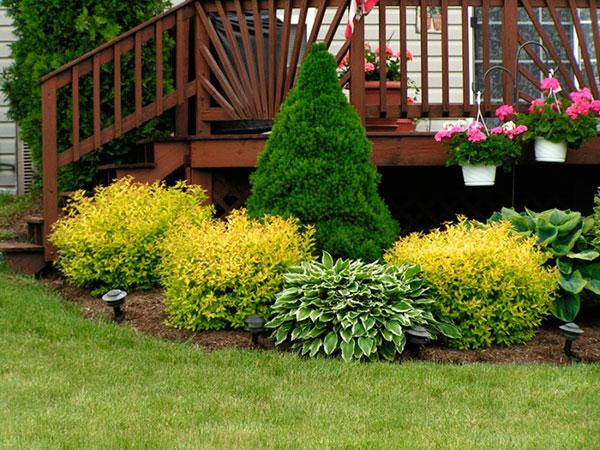
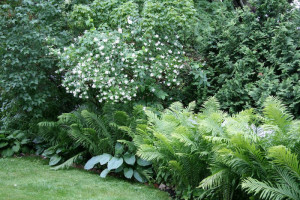
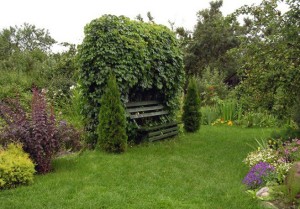
How to create a flower garden in the country with their own hands. A photo
Astilba flower arrangements in the garden
Composing flowers from roses in the garden
A variety of ornamental grasses in the garden
How to use decorative cereals in a flower garden
Today, landscape design has become a favorite hobby of many land owners and private houses. It is thanks to their efforts that the space that surrounds many private houses has recently become a major transformation.
On some garden plots orchards and even ordinary orchards are gradually beginning to lose ground and give way to decorative lawns, bright flower gardens and unexpected plant compositions that delight their owners.
But if, flower arrangements have always been in high esteem with our gardeners, and some, unpretentious shrubs it was always often possible to meet on plots, then coniferous evergreens in landscape design are not used so widely. Although their popularity is increasing.
Coniferous species in landscape design make it possible decorate the house space aesthetically and richly, in addition, the garden will look like this at all times of the year.
The increasing use of coniferous shrubs and trees in landscape design is due to their properties: the plants are harmonious in single plantings and compositions year-round, most species and forms are unpretentious to the soil, tolerate harsh weather conditions, less than deciduous, exposed to pests and diseases.
In addition to the aforementioned aesthetic effect, such landings compare favorably:
- Good absorption of street dust and noise;
- Windproof properties;
- Improving the microclimate in the local area;
Suppression of the multiplication of pathogenic viruses and bacteria, due to the release of biologically active substances by all parts of the plant;
Air supply all year significant amount of oxygen, as most conifers are not deciduous.
Therefore, if there is a dream of a green surrounding space, in which the most favorable microclimate for people will naturally be provided, then the composition of coniferous shrubs and trees in landscape design will be the best solution. Moreover, there is always the opportunity to choose plants of the most unexpected form and any size of crowns, this allows you to create any composition in your area.
 For planting and growing compositions of conifers, certain rules have already been formulated, which are well known to both professional botanists and landscape designers. But, since some site owners want to do the decoration themselves, while others simply do not have the financial ability to hire a qualified specialist, you must begin the process of creating a composition of coniferous from theoretical part.
For planting and growing compositions of conifers, certain rules have already been formulated, which are well known to both professional botanists and landscape designers. But, since some site owners want to do the decoration themselves, while others simply do not have the financial ability to hire a qualified specialist, you must begin the process of creating a composition of coniferous from theoretical part.
When planning a landing, you should immediately take into account that landscape compositions that are ready will look holistic, if the distance from the place from which they are most often inspected is at least two of their heights.
The essential point is the thorough preparation of the site for planting. From this will depend on its further development, and, consequently, the beauty of the entire composition. Unsuitable for landing places on the site, which are subjected to periodic flooding. It is necessary to take into account that each species develops best on a certain composition of the soil. This needs to be clarified at the stage of selecting species for your garden plot.
In terms of the most optimal time for planting is the period from the last days of April to the beginning of May. At that time conifer shrubs and the trees are not yet beginning active growth and as a result, they tolerate the transplant more easily and take root in a new place.
When digging a hole, it is necessary to calculate its depth in such a way that when planting a seedling it is located in it not deeper than the root collar (this is the boundary where the trunk passes into the root). After planting, it is necessary to water abundantly, this is done to ensure the best contact of the soil with the roots, that is, it is necessary to water regardless of the soil moisture. The next month should not allow the soil to dry out around the plants until it begins to develop its root system in a new place.
Most of the conifers - not very capricious when grown, but they, like other artificially grown plants, need care. In hot years, it is required to cover young plants from sunburn, especially for various fir trees. In winter - to carry out measures to protect the frost of the southern, introduced species (this is the shelter of low-growing plants, snow retention, etc.). Seedlings are sold with a closed root system (with a clod of earth or in a container) and with an open one (roots are bare). If planting occurs in the spring, and the roots are open, you need to pay attention to the presence of young roots.
Laying out a lawn to create a background for coniferous plants will significantly improve overall visual perception. Often, coniferous plants are planted near water bodies, so that, together with weeping deciduous plants, they form a common original composition.
 Landscape designers first of all recommend to give preference:
Landscape designers first of all recommend to give preference:
- different types and varieties of junipers: Cossack, rock, virgin, Chinese, etc .;
- spruce: barbed, European;
- pines: mountain, black, ordinary.
Those. those species of conifers that are common in the wild in our forests without any care. Naturally, wild plants are quite common. grow too large, they do not have sufficient decorative qualities, so you need to buy varieties with known qualities.
Junipers, pines and North American spruce ate quite light-requiring, undemanding to the level of moisture and fertility of the soil. If the flower bed is in shading for a significant part of daylight, it is recommended to choose zoned (that is, those that have been tested and are suitable for cultivation in your region) of the yew, European spruce or western thuja varieties.
For a low-maintenance garden (requiring a minimum of work during the year) in our latitudes, carefully purchase cypress trees, hemlock, pseudo-cobblestones, microbiota, tulevik, cypress, cupressciparis, fir, Kempfer's larch, Japanese cryptomeria, cypher swamp, folded yarn, and other maritimes, other blue cryptomeria, marsh cypress, folded yarn, and other creatures should use the rest of the body and other body patterns.
By the size of an adult plant conifers can be conditionally divided into three groups.
Tall species of conifers
Among the large plants can be considered such common types:

Sredneroslye plants for coniferous compositions
- El Conica. Branched and very aesthetic evergreen tree. Growth is slow.
- Yew berry. Compact shrub, dense needles. Popular due to the combination of rich greens and berries, red.
- Yew golden. It tolerates partial shade, combined with tall and short plants. Grows in the shape of a bowl, needles of yellowish-green, green or golden brown. Often serve as the basis for compositions.
Undersized and creeping cattle
For such forms of conifers, it is very important to have enough space for development, because they do not grow up, but in the horizontal plane, forming something similar to a kind of lawn.
- Spruce Lomber ordinary. Low-growing plant, the needles are thick, bright, emerald color.
- Pine mountain Hampi. Used in rock gardens. An unusual property - the kidneys, at a temperature below zero, are painted in beautiful reddish-brown shades.
- Mountain pine, variety Mini Pug. It grows in the form of a kind of pillow.
Compatibility
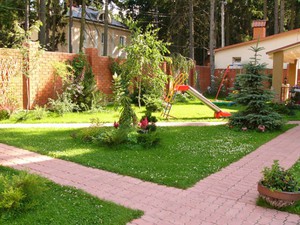 Despite the unpretentiousness of most species of conifers to growing conditions, to form compositions based on them, it is necessary to take into account some peculiarities. Many conifers are characterized by their “aggressiveness”. Aggressive called species, which in the process of evolution developed the ability to excrete substances that inhibit the development of other plants. In conifers such a feature allows in nature, with their very slow growth, to compete with fast-growing species. Therefore:
Despite the unpretentiousness of most species of conifers to growing conditions, to form compositions based on them, it is necessary to take into account some peculiarities. Many conifers are characterized by their “aggressiveness”. Aggressive called species, which in the process of evolution developed the ability to excrete substances that inhibit the development of other plants. In conifers such a feature allows in nature, with their very slow growth, to compete with fast-growing species. Therefore:
Near coniferous trees, all conifers do not feel well, although they can be planted, but at some distance.
Acquisition of plants
 Coniferous trees to create compositions can be bought both in special nurseries and in garden stores.
Coniferous trees to create compositions can be bought both in special nurseries and in garden stores.
Digging in natural forests and groves is not worth it, because, firstly, it may be illegal (if this territory belongs to a biosphere reserve), secondly, an adult plant is unpredictable, even wild specimens within one species can be very different (it depends on many factors and heredity), thirdly, it is possible to bring new types of pests into your garden.
You do not need to acquire a plant just because it is beautiful and pretty. Recommended necessarily learn latin name, first ask about the size and habit of the adult plant and buy only those plants that are suitable for a particular plot.
Conifers, especially those of small age, are strikingly similar and only a specialist is able to distinguish them externally. This is a rather expensive acquisition, calculated for more than one year, so you should prepare for it in advance, arm yourself with a catalog with descriptions and photos. Very often one has to see the disappointment of buyers of extremely expensive, grown in western nurseries, topiary (formed by special pruning seedlings) forms, when they are created from species that are not zoned in our latitudes.
It should not be forgotten that it is advisable to buy coniferous plants with a clod of earth, dendrological nurseries sell them in sackcloth or wire mesh, the best option - grown in a container, they may be land in any season. Naturally, you need to buy seedlings only in reputable garden centers, after checking the general condition of the needles and the quality of the root system. A lot of beginning gardeners “burned”, having bought cheap cupressciparis and cypress trees in pots, which are often realized in supermarkets, often they stand there, without watering, for weeks. After such conditions, these delicate plants are restored extremely hard, most often die during the first wintering.
As for the price of saplings, conifers, more often, cost more than deciduous, container - more expensive than those grown in the soil, grafted and topiarnyh - more expensive than those grown without forming, etc. Designers most often recommend buying several accent, central plants (size about 1.0-1.5 m in height), to give the flowerbed volume, and the rest to buy small (no more than 40 cm). But you need to be prepared for the fact that dwarf species grow extremely slowly (sometimes less than one cm per year) and after dropping them off very small, for many years you need to expect from them the desired decorative effect.
Coniferous compositions in landscape design
The principle of building a landscape composition of coniferous plants
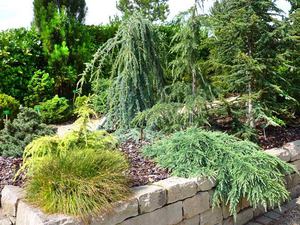 For proper planning of the composition of conifers, it is initially necessary to decide where it should be located, which species is needed, which elements will be included in it. And after that, choose plants that meet the characteristics necessary for the formation of the composition, taking into account the existing conditions.
For proper planning of the composition of conifers, it is initially necessary to decide where it should be located, which species is needed, which elements will be included in it. And after that, choose plants that meet the characteristics necessary for the formation of the composition, taking into account the existing conditions.
The facade of the house and the front garden, as a rule, are the first to be seen by the guests, so its design should be somewhat solemn and necessarily elegant, appropriate here. landscaping with basic elements regular style, which is based on a symmetrical arrangement of all components or a repetitive rhythm. It will be better when the range of species here is too diverse.
The main accent plant is a pyramidal, shtambovoe plant, which in adulthood reaches a size of not more than 2.5-3 m (based on the size of the flowerbed). Then, symmetrically from it, on the sides, second-order plants (subaccents) are located, with dimensions up to 1-1.5 m. Between them it is possible (without deviating from the pre-planned pattern) to plant dwarf and open conifers, compact ornamental-leaved shrubs and ground cover.
In landings of an informal style, compositions of coniferous plants are recommended to be placed on the lawn. in the form of a bed - "island", to include them in the mixborder along the edges of the site, interspersed with ornamental plants, thus zone the space. Here it is more optimal to select the habit of the plants according to the “irregular versatile triangle” system.
After that, the remaining space is filled with plants as their significance and external saturation decrease. In the foreground, flower beds land more low plants, and to the center - higher and more voluminous. It is advisable to choose plants with different colors of needles, so that the flowerbed does not look boring. If the accent plant has a silvery color of needles, it is not necessary to plant a variety of the same color next to it. Do not forget about the backlight flower beds and various seasonal plants. On the background of bright green early bulbous will look great.
For planting on an alpine hill or in flowerbeds with different annuals and ground cover, you can use miniature varieties with spherical and pillow forms of growth, as well as ground cover species that cover the ground with a carpet or cascade down from the retaining walls.
To create a harmonious landscape composition, it is necessary to take into account certain rules.
Shape geometry
Contrast combinations
By combining contrasting colors and shapes, various visual effects can be achieved. On the background of small plants, large-sized trees will be noticeable; in transitions of various sizes and crown shapes you can smooth out the exterior lines.
Asymmetry and symmetry
The use of conifers, in landscape design, involves a combination of incompatible. That is, it is possible to design the plot with both symmetrical compositions and unexpected asymmetric elements that will look quite harmonious.
 At the moment, a large number of coniferous plants, differing in color. Those who like to experiment with colors should remember that contrasting colors components of a small coniferous group can "ruin" the composition. Therefore, experts advise in groups of conifers, of three plants, to use no more than two colors, in groups of five seedlings you can plant no more than three colors. But in significant coniferous groups (more than 30), you can plant plants with different colors, not forgetting to combine them into small groups of three plants of one color.
At the moment, a large number of coniferous plants, differing in color. Those who like to experiment with colors should remember that contrasting colors components of a small coniferous group can "ruin" the composition. Therefore, experts advise in groups of conifers, of three plants, to use no more than two colors, in groups of five seedlings you can plant no more than three colors. But in significant coniferous groups (more than 30), you can plant plants with different colors, not forgetting to combine them into small groups of three plants of one color.
Crown height and shape
Creating compositions, it is necessary to take into account not only the color of the seedling, but also its dimensions in adulthood and the outline of its crown. In order to predict the type of composition in the future, you should first examine the characteristics of the proposed varieties before buying them.
Types of compositions
Mixborder
Mixborder can be placed where, in accordance with the wishes of the owner of the site, it will be best to look. Do not be afraid to do as you wanted. From the manifestation of individuality garden landscape only wins.
For the largest plants you need prepare a place on the very edge of the future composition, further plantings are arranged in descending dimensions, therefore the lowest growing plants are planted at the base of the mixborder. No need to strive to maintain unchanged geometric accuracy of plantations. The curvature will only emphasize the pristine beauty of the composition.
The natural harmony of the mixborder must be respected: the width of plantings of large plants must necessarily exceed the space that is allocated under undersized planting. The plantings may include specimens that differ in the color of the needles and the outline of the crown.
Coniferous hedge
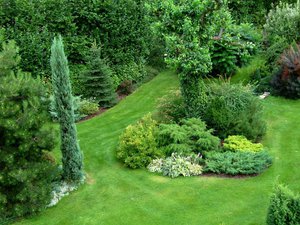 A hedge, using coniferous plants, create quite often. In the landings of the regular style, which is rarely found in our latitudes, coniferous hedge is nothing more than a hedge, but landscape style and modern makes it possible to apply evergreen hedges as a backdrop for bright perennials. Thick formed or unformed hedges can be formed from conifers. In order to create a dense green fence plants are placed in several rows, in a checkerboard pattern. One of the most impassable fences is rightly considered to be a spruce shaped chess boarding.
A hedge, using coniferous plants, create quite often. In the landings of the regular style, which is rarely found in our latitudes, coniferous hedge is nothing more than a hedge, but landscape style and modern makes it possible to apply evergreen hedges as a backdrop for bright perennials. Thick formed or unformed hedges can be formed from conifers. In order to create a dense green fence plants are placed in several rows, in a checkerboard pattern. One of the most impassable fences is rightly considered to be a spruce shaped chess boarding.
Compositions from coniferous circular review
The compositions of the circular view call planting, the decorative effect of which should be viewed from all sides of the review. Compositions of this kind are usually planted in pavement openings or on round flowerbeds. Planting, maybe any - irregularly shaped or symmetrical. In the center of the symmetric composition is placed the most dimensional plant, around it at an equal distance - the types of small dimensions.
For asymmetrical groups, the same principle applies: the height of each subsequent row should gradually decrease, thus emphasizing the visual perception of the previous row. The formation of an asymmetrical composition is one of the most difficult works for a landscape designer. It is necessary to provide an overview of landing from all angles.
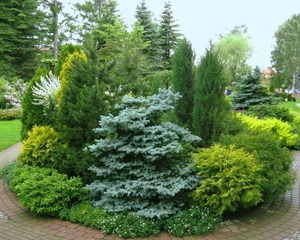 For example, consider the option of using Scots pine as an accent plant. It is necessary to choose a variety of this tree, reaching a height of 2-2.5 m, with a small bluish-gray needles.
For example, consider the option of using Scots pine as an accent plant. It is necessary to choose a variety of this tree, reaching a height of 2-2.5 m, with a small bluish-gray needles.
In front of it, a specimen of slow-growing, fairly frost-resistant cedar Korean pine is planted, a pyramidal-shaped variety with long needles of silver-blue hue is desirable. In the corner of the composition can be placed three Cossack juniper. To the left of their land two slow-growing dwarf. In the composition you can add a few western thujas. The space between the plants is covered with a layer of decorative mulch, in its quality it is aesthetically pleasing to use milled fir cones. Such a composition does not need special care.
Composition with a geometric shape of the crown
In such a composition spruce spruce with a bluish-white color of needles will look good. The height of the selected grade should not be more than 3-4 meters.
To the left it can be placed thuja western, a variety with a narrow cone-shaped crown. Four plants of a slow-growing mountain pine, a variety of spherical shape with dark green needles, will look good between spruce and thuja. There are varieties of mountain pine with the original property - they have needles, with the first frost, turns yellow, and the green color returns in spring.
In addition to these, there is still a huge variety of different compositions and combinations of plants. This article lists only some of the most common.
Conclusion
 Here, in brief, the basics of creating coniferous compositions. But this information is only an invitation to full of creativity and beauty world landscape design, in general, and the creation of coniferous compositions in particular.
Here, in brief, the basics of creating coniferous compositions. But this information is only an invitation to full of creativity and beauty world landscape design, in general, and the creation of coniferous compositions in particular.
It is possible for any person to turn both a significant plot and a small platform, near the house, into a unique and unique composition of living plants. This is not as difficult as it may seem at first glance - a little patience, knowledge and your own imagination.

